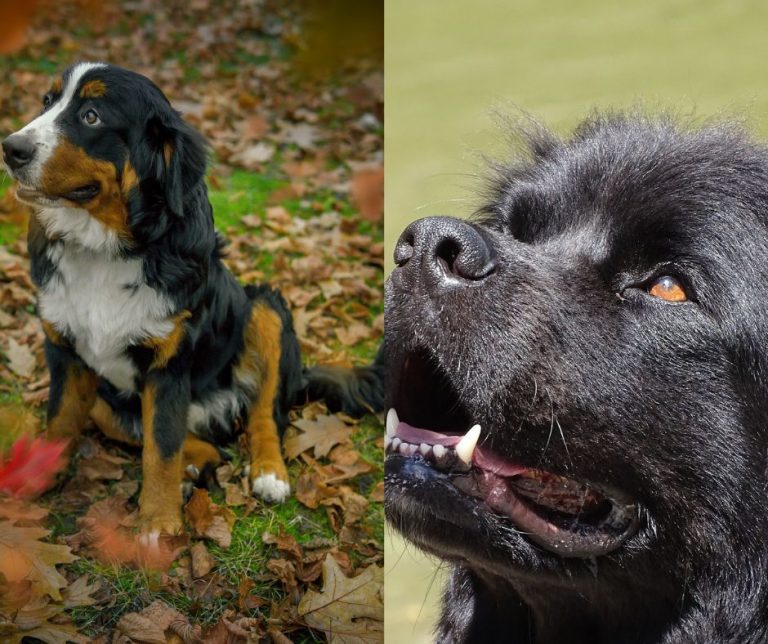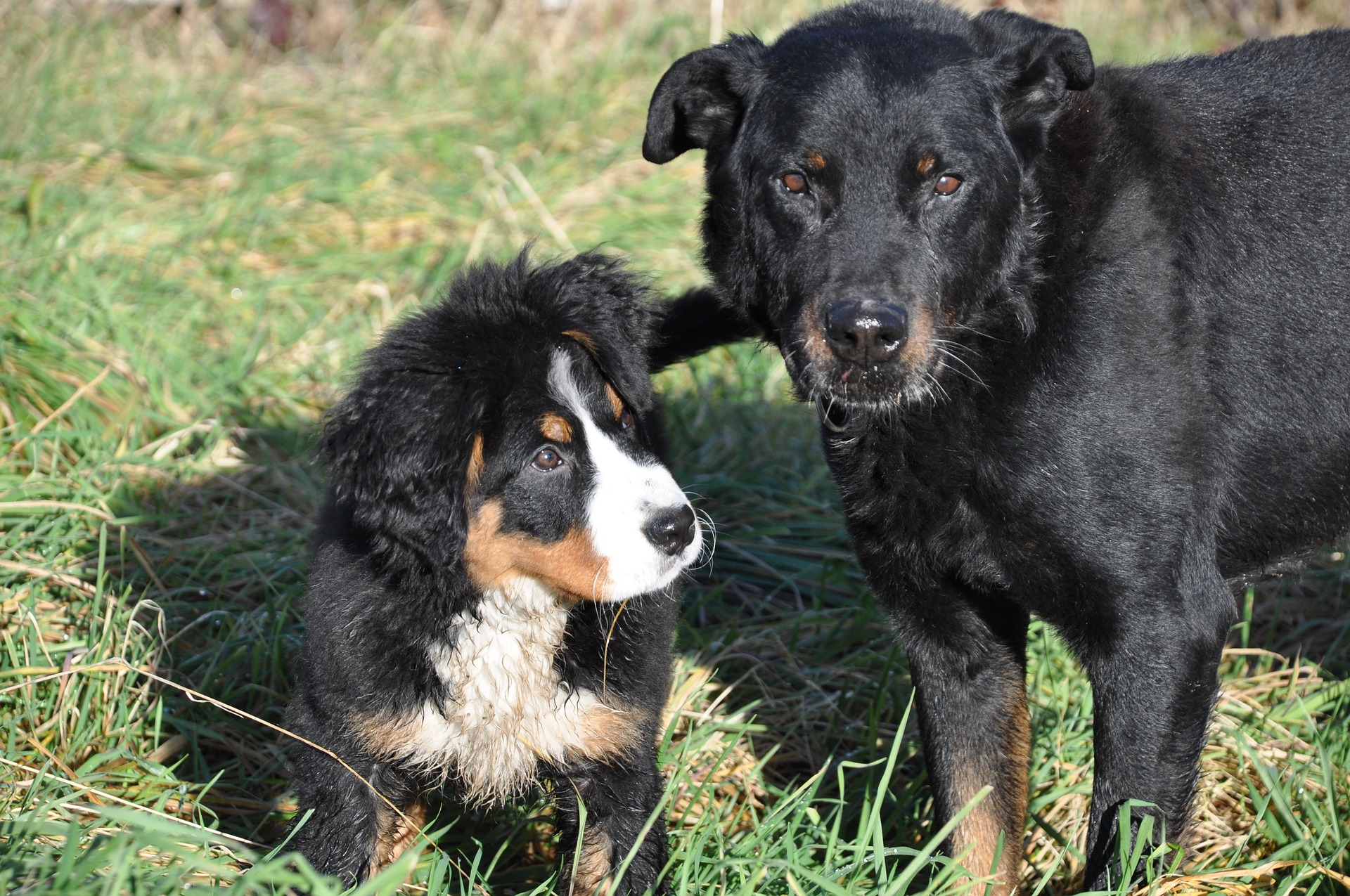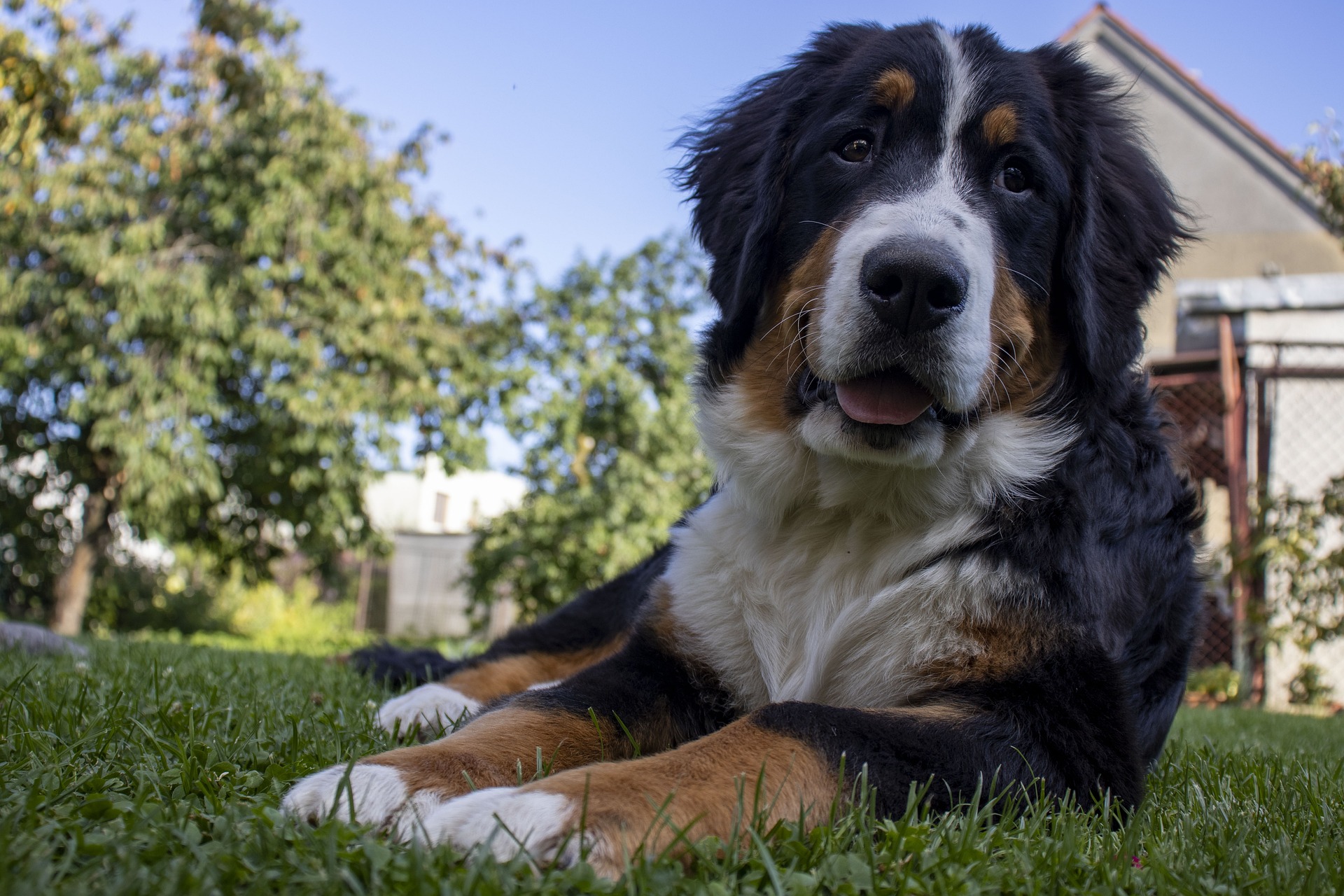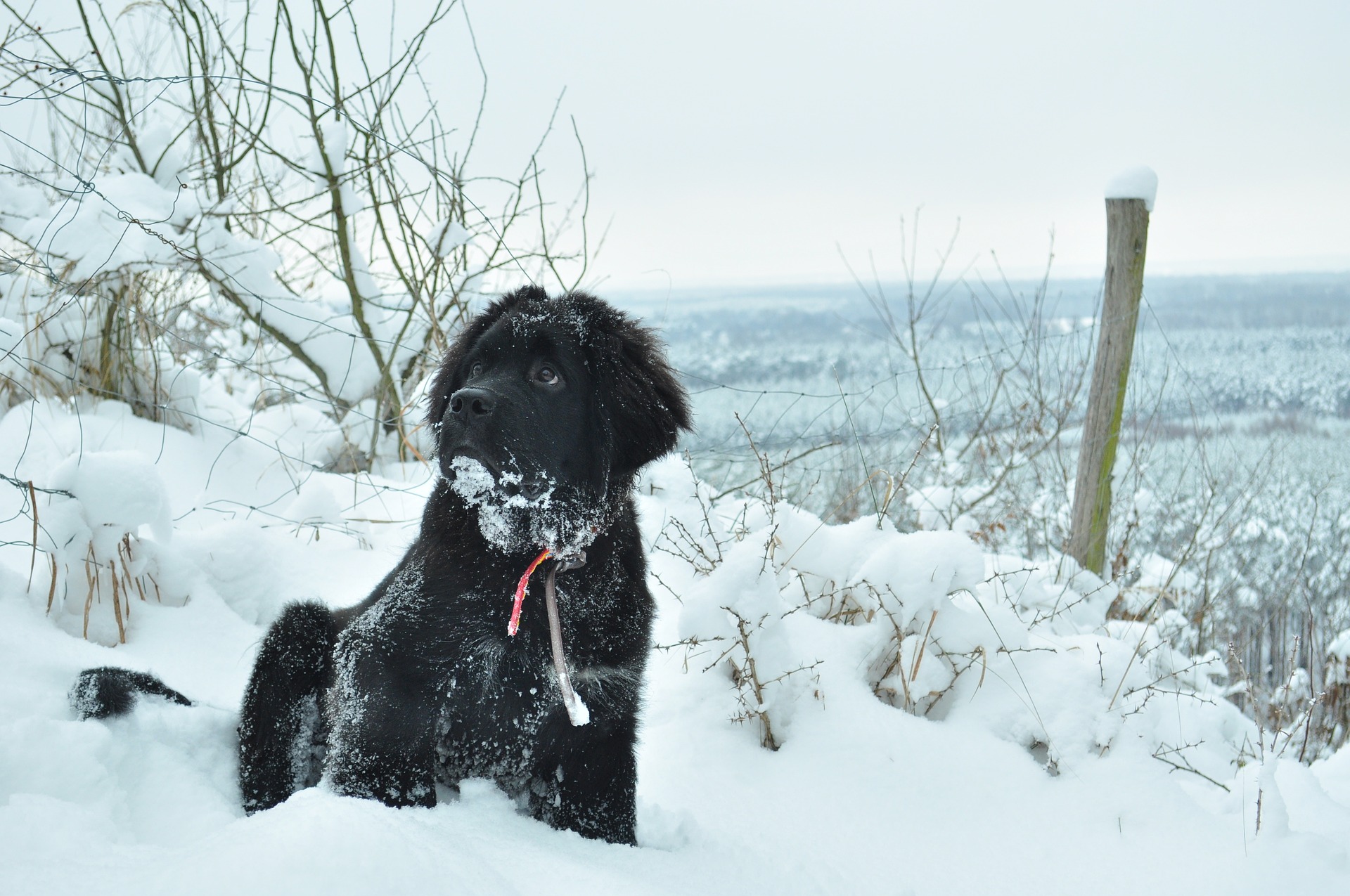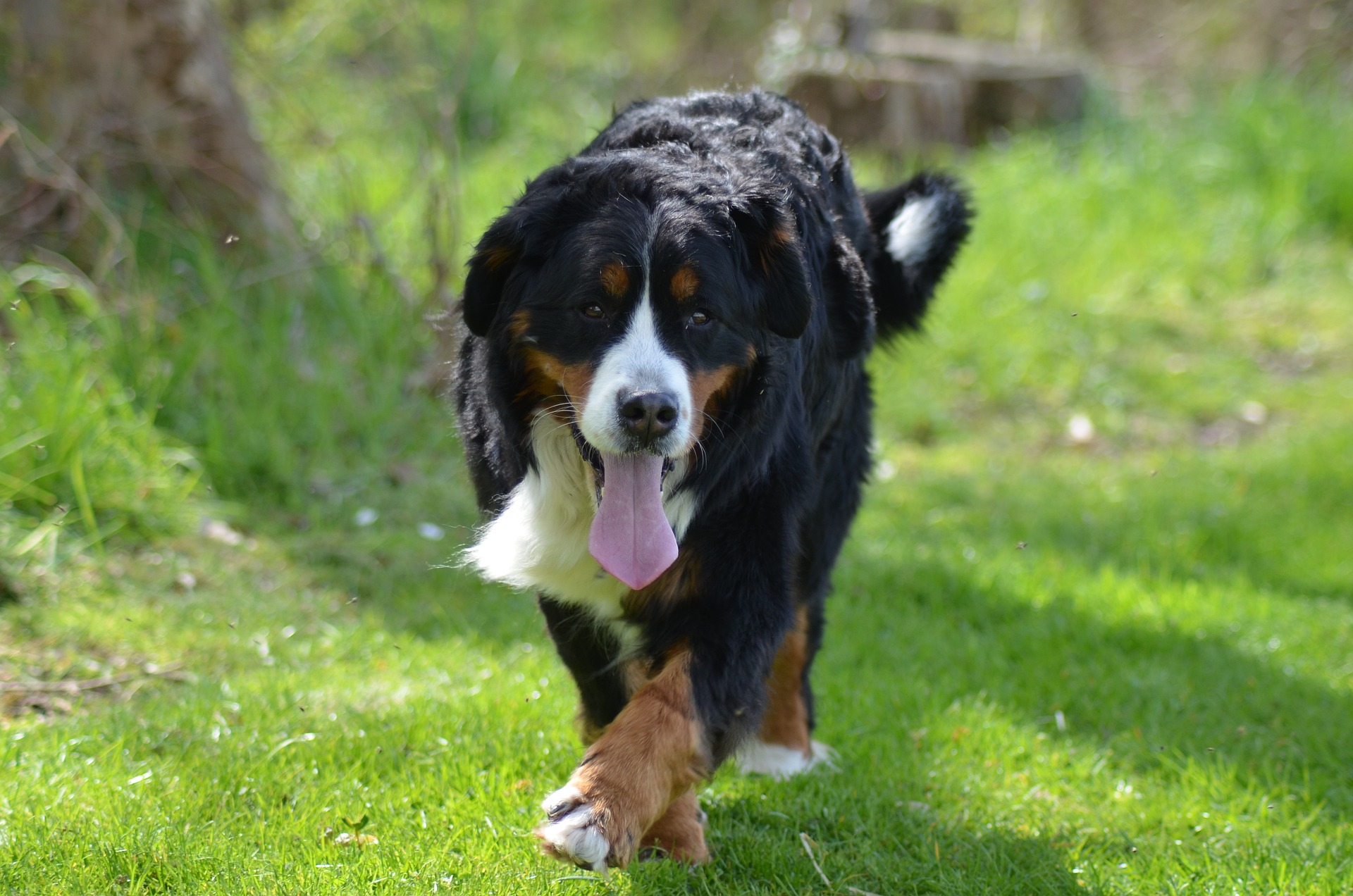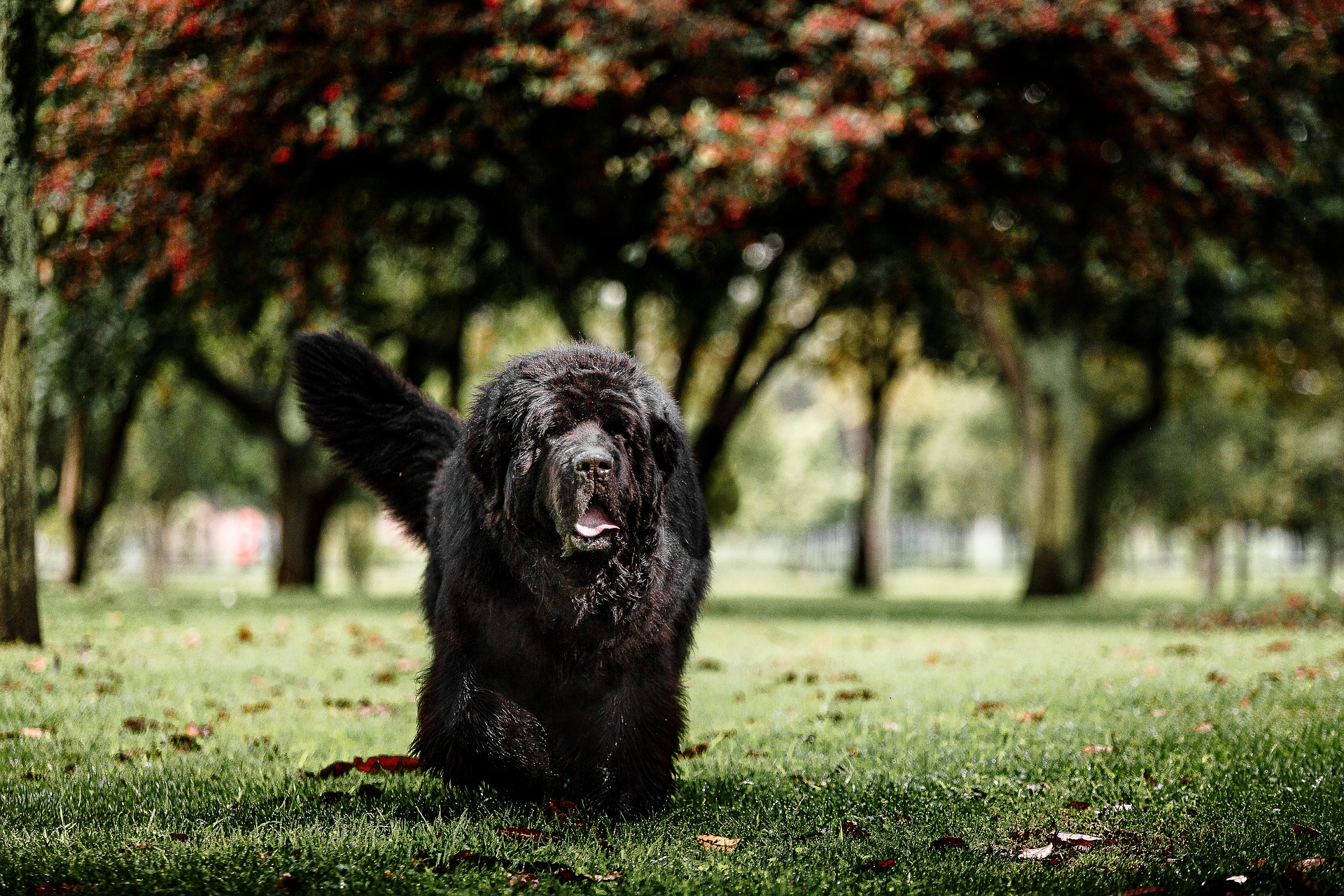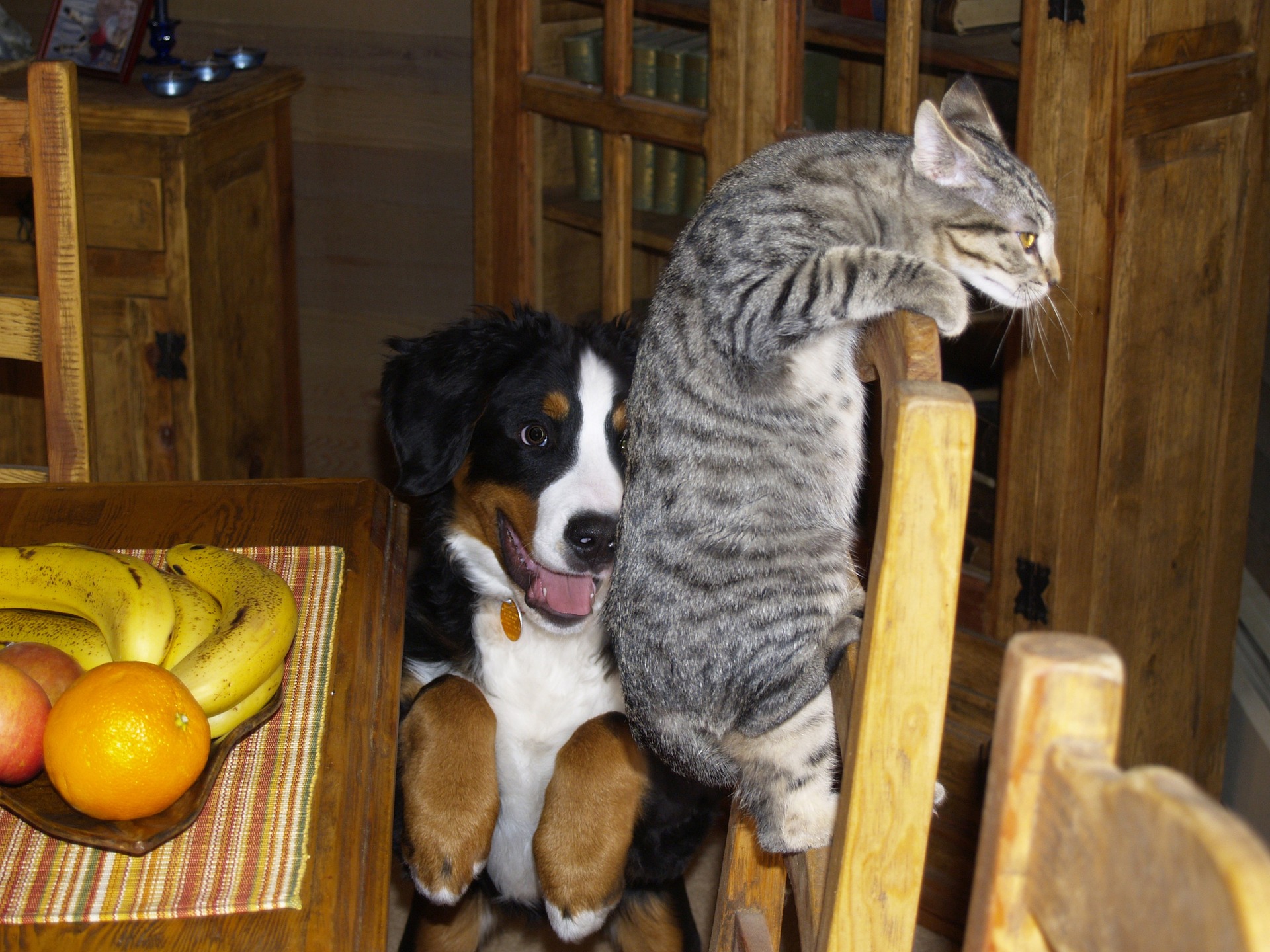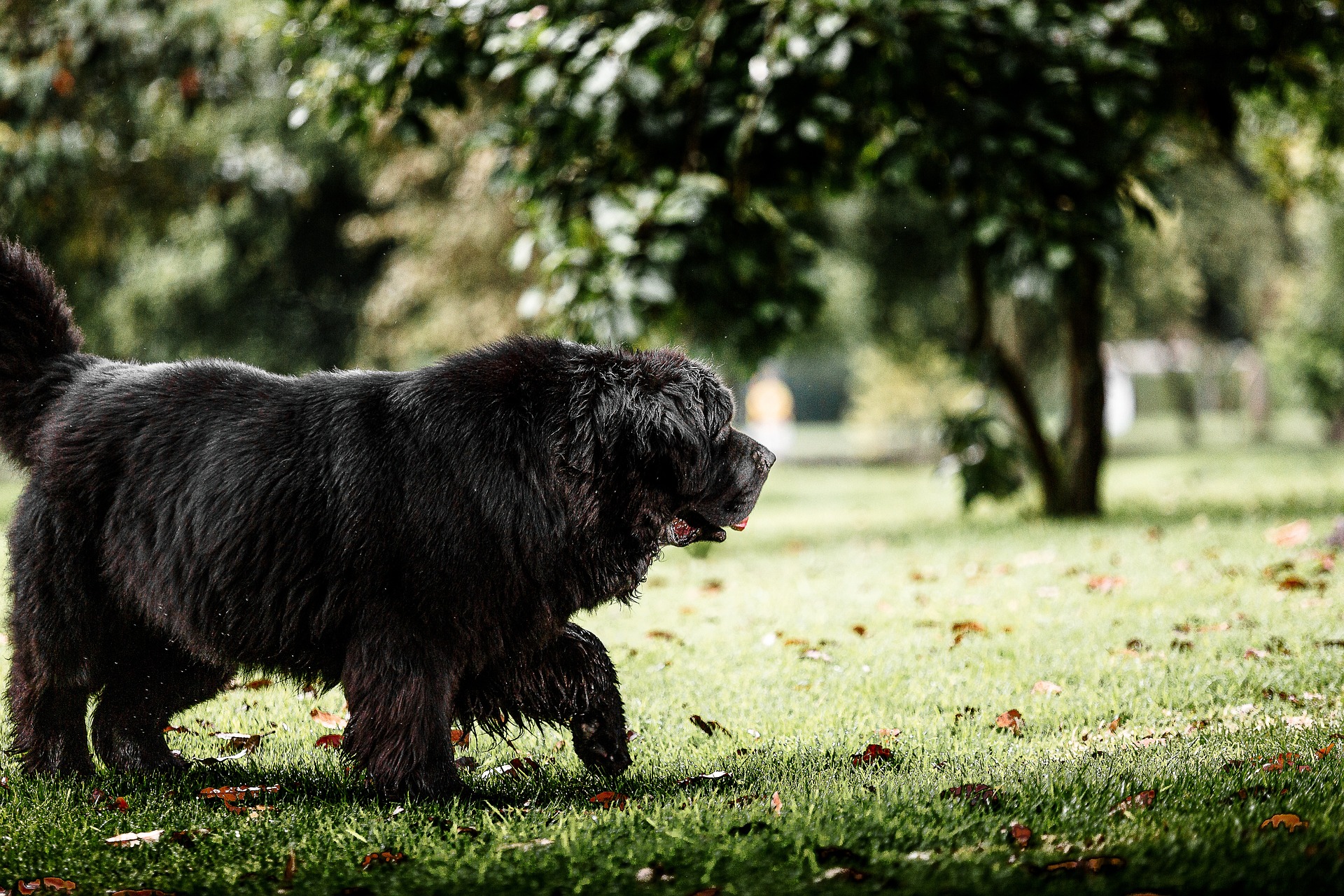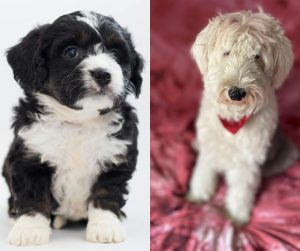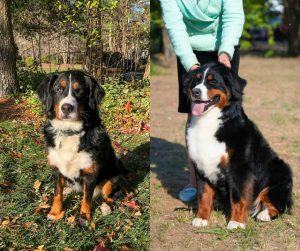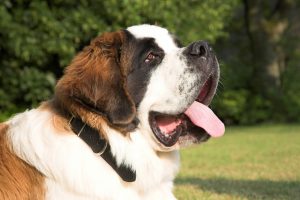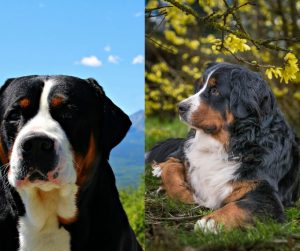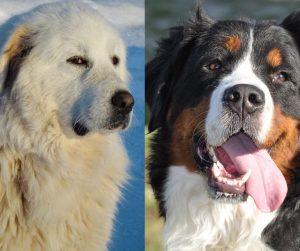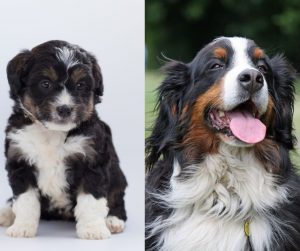Choosing between a Bernese Mountain Dog and a Newfoundland for a family pet is like picking between two gentle giants. Both breeds boast friendly dispositions perfect for family life. While they share similarities in their loving nature, they differ in physical characteristics and certain care requirements.
Bernese Mountain Dogs, with their tri-colored silky coats, are recognized as large breed dogs, while Newfoundlands are known for their even greater size and strength.
Despite the larger stature of the Newfoundland, which can tip the scales further than the Bernese, these breeds hold a common reputation for being intelligent and relatively easy to train, making them suitable for both novice and experienced dog owners. They both display a good balance of energy suitable for family activities, yet have different grooming needs and levels of drooling – considerations that potential owners should keep in mind.
When contemplating which breed to welcome into one’s home, it’s essential to consider factors like the dog’s energy level, size, and grooming needs. Each of these plays a significant role in fitting into a family dynamic. The Bernese Mountain Dog and the Newfoundland each have unique attributes that can make them the perfect companion for the right household.
Today, we will look at the Bernese Mountain Dog vs Newfoundland dog breed comparison. Let’s take a look.
Key Takeaways
- Bernese Mountain Dogs and Newfoundlands are both friendly, large breeds ideal for families.
- They require different levels of care, especially regarding grooming and drooling.
- Considering characteristics like size and energy is crucial in choosing the right breed for a home.
Origins and History
When one traces the lineage of Bernese Mountain Dogs and Newfoundlands, it’s like taking a step back to the charming countryside of Switzerland and the rugged coastal shores of Canada. Each breed has a rich heritage and distinct roles that they played in their native lands.
Bernese Mountain Dogs from Switzerland
The Bernese Mountain Dog hails from the pastoral landscapes of Switzerland, a breed with roots as a versatile farm dog. In the rolling hills and valleys of the Swiss Alps, they were trusted companions for herding cattle and served as all-purpose helpers. Not just herders, Bernese Mountain Dogs were also accustomed to pulling carts and guarding farms. The intricate tapestry of their origin weaves together mastiffs and sheepdogs, contributing to their strength and intelligence.
These dogs bring with them not just a history of hard work, but also a temperament that made them beloved by those who valued loyalty and gentle companionship. The Bernese Mountain Dog is closely related with other dogs from the Alps, like the Saint Bernard and the Greater Swiss Mountain Dog.
Newfoundlands from Canada
In contrast, Newfoundlands originate from the cold and harsh environment of Newfoundland and Labrador in Canada. They were indispensable to the Canadian fishermen, not only for their company but also for their impressive work in the water. Newfoundlands are the very essence of water dogs, with a natural ability to perform spectacular water rescues.
Their colossal size and thick fur coat equipped them to handle the icy Atlantic waters, and their gentle nature made them excellent working dogs on both land and sea. The Newfoundland dog stands as a testament to the harmonious relationship between human and canine, helping and protecting their human families in the unforgiving Canadian climate.
Physical Characteristics
When choosing between Bernese Mountain Dog vs Newfoundland dog breed, potential dog owners often consider their physical characteristics, which include size differences, coat variations, and distinct physical features. Both breeds are large and imposing, yet they carry their size with grace. The breed standard for each canine is set by the American Kennel Club.
Size: Height and Weight
Newfoundlands generally tend to be larger than Bernese Mountain Dogs. An average male Newfoundland stands between 27 to 29 inches tall, whereas females typically measure between 25 to 27 inches. In terms of weight, they range significantly, with males weighing anywhere from 130 to 150 pounds and females being slightly lighter, often around 100 to 120 pounds.
In contrast, male Bernese Mountain Dogs are commonly found in the height range of 25 to 28 inches, with females slightly shorter, measuring around 23 to 26 inches. Weight-wise, males fall into the 80 to 115 pounds bracket, while females tend to weigh between 70 to 95 pounds.
Coat Colors and Types
Both breeds boast impressive coats that serve as much for warmth as for aesthetic appeal. Newfoundlands have a dense, water-resistant double coat fit for their history as working dogs in Canadian waters. Their colors typically include solid black, brown, grey, or a black-and-white mix known as Landseer.
Bernese Mountain Dogs impress with a thick, long, and silky tri-color coat – distinctive black fur with white chest and rust-colored markings above the eyes, sides of the mouth, front of the legs, and a small amount around the white chest.
Distinctive Features
One cannot talk about these dogs without mentioning the Newfoundland dog breed’s large, bear-like head and the Bernese Mountain Dog’s gentle, expressive eyes that seem to always be seeking your approval. They both have strong, muscular builds, but the Newfoundland overall exudes a more powerful stature, while the Bernese maintains a certain agility not always seen in giant breeds.
Temperament and Personality
Choosing between a Newfoundland and a Bernese Mountain Dog puppy is a matter of matching your family’s lifestyle to a dog’s temperament. Both breeds are known for their gentle nature and loving personality, but they do have their distinct behavioral traits and ways they interact with families.
Behavioral Traits
Newfoundland dogs are renowned for their calm and docile personality, often referred to as “gentle giants.” They possess a loyal and protective character, especially around children, making them excellent family dogs. Their high intelligence and eagerness to please contribute to their respectable trainability. Newfoundlands are not typically shy; they usually greet visitors with mild curiosity rather than suspicion or anxiety.
The Bernese Mountain Dog, on the other hand, is recognized for its vigorous personality and high energy levels, needing plenty of exercise to stay mentally and physically healthy. These dogs are intelligent and affectionate, often forming strong bonds with their owners. Berners carry a sense of playfulness into adulthood and are known for their friendly demeanor.
Affection and Interaction with Family
Both Newfoundlands and Bernese Mountain Dogs score high on affection. A Newfoundland’s interaction with family is often marked by gentle gestures, showing their affection in subtle, kindly ways. They tend to be patient with kids, understanding of their unpredictability, and are known for their inherent ability to protect and care for their family members.
Bernese Mountain Dogs shine in their interaction with family with a more playful approach. They are known to be loyal companions that will shower their family with affection, often striving for attention and physical closeness. Their temperament makes them a joy around children, and they are generally patient and kind with family members of all ages.
Training and Intelligence
When it comes to dog training and intelligence, the Bernese Mountain Dog and Newfoundland breed both exhibit qualities that make them beloved by trainers. They share an eagerness to please and are known for their obedient nature, which translates into a generally smooth training experience.
Ease of Training
Bernese Mountain Dogs are often seen as eager to please, making them relatively easy to train. Their intelligence and obedient temperament mean they listen attentively and can pick up on new commands quickly. With consistent and positive training methods, they often excel in learning the desired behaviors.
- Ease of Training: Generally high
- Training Tips: Use positive reinforcement; keep sessions engaging
Newfoundlands also display an inclination for being easy to train, thanks largely to their smart and loyal characteristics. Their gentle disposition means they respond well to a kind and patient training approach.
- Ease of Training: High, with patience required
- Training Tips: Gentle guidance; reward-based training works well
Problem-Solving Skills
When it comes to problem-solving skills, the Bernese Mountain Dog’s intelligence shines. They’re not just about following commands; they can watch a situation and react appropriately. Their smarts are one of the reasons they’re used in various canine jobs, such as search and rescue operations.
Newfoundlands, too, are smart but in a more deliberate way. They may take a bit longer to assess a situation, but they’re excellent problem solvers once they understand what is expected of them. Their legendary roles as rescue dogs speak to their inherent ability to think critically in challenging situations.
Both breeds benefit from mental stimulation to keep their intelligent minds engaged, so incorporating puzzle toys or advanced training exercises into their routine can be especially rewarding for them.
Exercise and Energy Levels
Both the Bernese Mountain Dog and the Newfoundland have significant exercise needs that are crucial to their health and happiness. Understanding their unique requirements will help one provide the right balance of activity for these large, energetic breeds.
Daily Exercise Needs
Bernese Mountain Dogs possess a high energy level and require daily exercise to maintain their vigor and prevent boredom. Ideally, one should provide at least 30 minutes of moderate exercise daily, such as walks or playtime. They are intelligent and obedient, enjoying activities like hiking and agility training that also stimulate their mind.
Newfoundlands are friendly and loyal with inherently high intensity in their activities. Even though they appear more sedate than Bernese Mountain Dogs, they still need about an hour of exercise daily. This could be in the form of long walks, swimming, or a game of fetch to satisfy their need for activity and companionship.
Adaptability to Living Spaces
Because of their size and energy, Bernese Mountain Dogs do best in homes with access to a yard where they can roam and play. However, they can adapt to indoor living provided they get ample daily exercise to dispense their energy.
Newfoundlands can also adapt to indoor life but require sufficient space due to their large size. They have a calm demeanor that makes them less demanding in terms of living spaces, but they still benefit greatly from having a yard to explore and relax in. Regular walks are essential to keep them happy and healthy.
Health and Lifespan
When choosing between a Newfoundland and a Bernese Mountain Dog, prospective pet owners should be well-informed about each breed’s health challenges and expected lifespan.
Common Health Issues
Newfoundland
- Hip Dysplasia: A genetic condition where the thigh bone doesn’t fit snugly into the hip joint
- Elbow Dysplasia: Similar to hip dysplasia, affecting the elbow joints
- Cystinuria: A hereditary kidney disease
- Subvalvular Aortic Stenosis (SAS): A heart condition that can be found in some Newfoundlands
Bernese Mountain Dog
- Hip Dysplasia: This breed is also prone to this joint issue, leading to arthritis or lameness
- Elbow Dysplasia: Elbow joint concerns can also trouble Bernese Mountain Dogs
- Progressive Retinal Atrophy: A degenerative eye disorder that can lead to blindness
- Cancer: Unfortunately, Bernese Mountain Dogs have a higher prevalence of cancer than many other breeds
Life Expectancy Comparisons
- Newfoundland: A lifespan of 8-10 years on average
- Bernese Mountain Dog: Generally experience a 6-8 year lifespan
They should be mindful of the common health issues that can affect these breeds, such as elbow and hip dysplasia, which can impact a dog’s quality of life and mobility. Like any large dog breeds, they are also susceptible to certain genetic health problems that can influence their overall life expectancy.
Regular veterinary check-ups and an active, well-managed lifestyle are critical for their well-being.
Care and Grooming
Taking care of a Bernese Mountain Dog or a Newfoundland giant breed means understanding their grooming and dietary needs. From managing their thick coats to providing the right nutrition, owners must be diligent in maintaining their overall health and well-being.
Grooming Requirements
Both breeds have thick, double coats that require regular grooming.
The Bernese Mountain Dog’s long fur tends to shed throughout the year, with a significant increase during the spring and fall. They typically need brushing several times a week to remove loose fur and prevent matting.
On the other hand, the Newfoundland has a water-resistant coat that also sheds, especially in the warmer months.
They do well with a consistent grooming routine, including weekly brushing and the occasional bath to keep their coat clean and reduce the amount of hair around the house.
Diet and Nutrition
The diet and nutrition of these large breeds are pivotal in maintaining their health. Both require high-quality dog food that matches their age, size, and activity level.
For Bernese Mountain Dogs:
- Protein-rich diet to support muscle development
- Controlled calorie intake to prevent obesity, which they are prone to
For Newfoundlands:
- Balanced diet with enough fat to support their thick coat
- Frequent, smaller meals preferred to prevent bloat, a common issue in large dog breeds
Owners should consult their veterinarian to tailor the diet to their dog’s specific needs, as individual dogs may have different requirements.
Regular checks on their weight and adjustments in their diet are crucial – one size does not fit all.
Choosing Between the Two Breeds
When deciding between the Bernese Mountain Dog vs Newfoundland, prospective pet parents find themselves comparing two equally endearing, large breed dogs.
Each giant breed boasts a reputation for being loving and patient. These qualities have earned them the nickname “gentle giants” across dog communities. These two are in the same category as the St Bernard and Greater Swiss Mountain Dog. They are amazing mountain dogs, but they can also be lovable pets in the family.
Bernese Mountain Dog:
- Size: Generally 23-28 inches in height and 70-115 pounds in weight
- Lifespan: Averages 6-10 years
- Temperament: Known for being obedient, intelligent, and showing high energy
- Health: May be prone to genetic health issues
- Grooming: Requires regular maintenance
- Exercise: Needs an active lifestyle
Newfoundland:
- Size: Slightly larger, standing 25-29 inches tall and 100 to 150 pounds
- Lifespan: Typically 8-10 years
- Temperament: Proudly patient, gentle, and great with families
- Health: Also has potential for genetic health problems
- Grooming: Moderate grooming needs compared to the Bernese
- Exercise: Requires moderate exercise; not as high energy as the Bernese
These breeds share a common thread of being super friendly. They are curious companions who blend well into family settings. However, the Newfoundland might have a more reserved demeanor compared to the often more vivacious Bernese.
Before choosing, make sure to talk to breeders and meet the puppies. This will help you understand the unique personality of each dog.
A purebred dog from a reputable breeder will come with health clearances and history. This gives you a glimpse into the potential future health of your beloved pet.
The choice between these large, affectionate dogs often boils down to personal preference regarding size, activity level, and maintenance.

